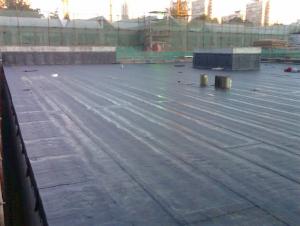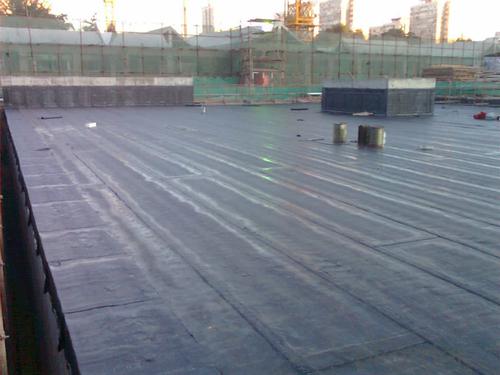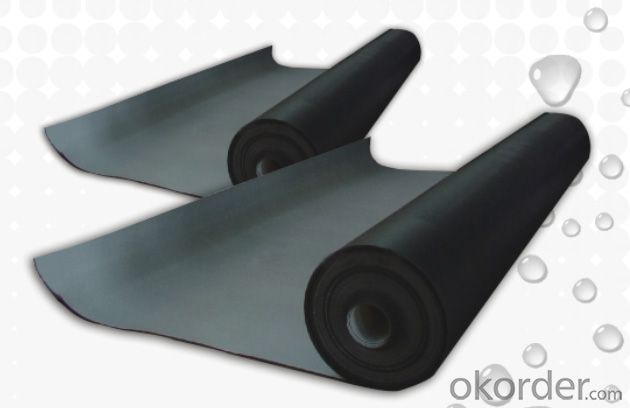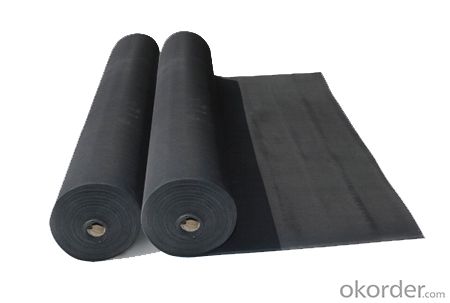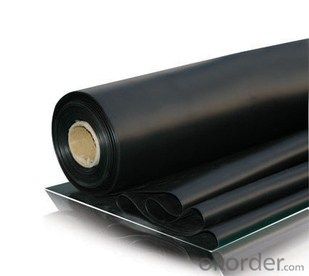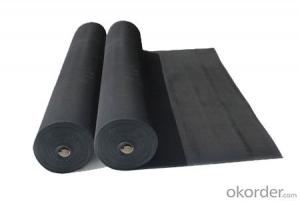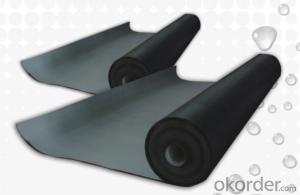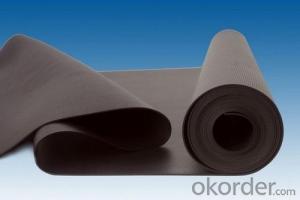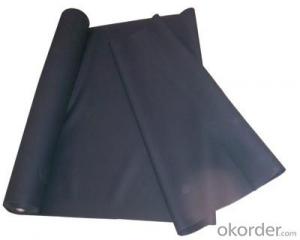EPDM Coiled Waterproof Membrane with 1mm Thickness
- Loading Port:
- Shanghai
- Payment Terms:
- TT OR LC
- Min Order Qty:
- 50000 m²
- Supply Capability:
- 5000000 m²/month
OKorder Service Pledge
OKorder Financial Service
You Might Also Like
EPDM Coiled Waterproof Membrane with 1mm Thickness
Description Of EPDM Coiled Waterproof Membrane with 1mm Thickness:
1. Excellent physical and mechanical performance, high tearing resistance;good deformation adaptability, high puncture resistance;
2. High aging resistance, high UV resistance, anti-acid & alkali;
3. Excellent low & high temperature resistance, innocuous, long life span;
4. Perfect water proof performance, seepage and humidity resistance.
Main Features of EPDM Coiled Waterproof Membrane with 1mm Thickness:
A.Polyester based SBS Modified Bitumen Waterproofing Membrane
a. Strong impermeability
b. High tensile strength, elongation, ability to adapt the grassroots shrinkage deformation and cracking
c. Puncture-resistant, broken resistant, tear-resistant
d. The corrosion resistance, resistance to mildew, weathering good
e. Construction convenient, hot-melt can be operated Four Seasons Construction, reliable joints
B. Fiberglass based SBS Modified Bitumen Waterproofing Membrane
a. High tensile strength, stability of a good size
b. High Temperature good performance
c. Damage resistance, corrosion resistance, resistance to mildew, weathering good performance
d. Good construction performance, reliable joints.
Specifications of EPDM Coiled Waterproof Membrane with 1mm Thickness:
| Material | EPDM Rubber |
| Size | 1.2m (width)*20m (length) or customized, weldable type 2.05m or 4m width |
| Thick | 1.2mm, 1.5mm, 2.0mm |
| Type | Vulcanized & Weldable |
| Pattern | Non-reinforced (homogeneous) |
| Certificate | ISO9001/14001 |
Applications of EPDM Coiled Waterproof Membrane with 1mm Thickness:
geomembrane used in groundsill of road, highway, railway and waterproof layer of swelling clay and wet collapsed loess.Geomembrane can be widely used in areas of garbage burying, waste disposal and underground construction projects.such as below:
- aquaculture ponds
- Ouchi root barrier membrane
- Floating baffles;
- Process wastewater
- Stormwater impoundments;
- Secondary containment;
- Spill containment
- Manure and biogas tanks and covers
- Potable water tanks and covers;
- Sludge Drying beds;
- Bioremediation covers & liners;
- Leachate ponds

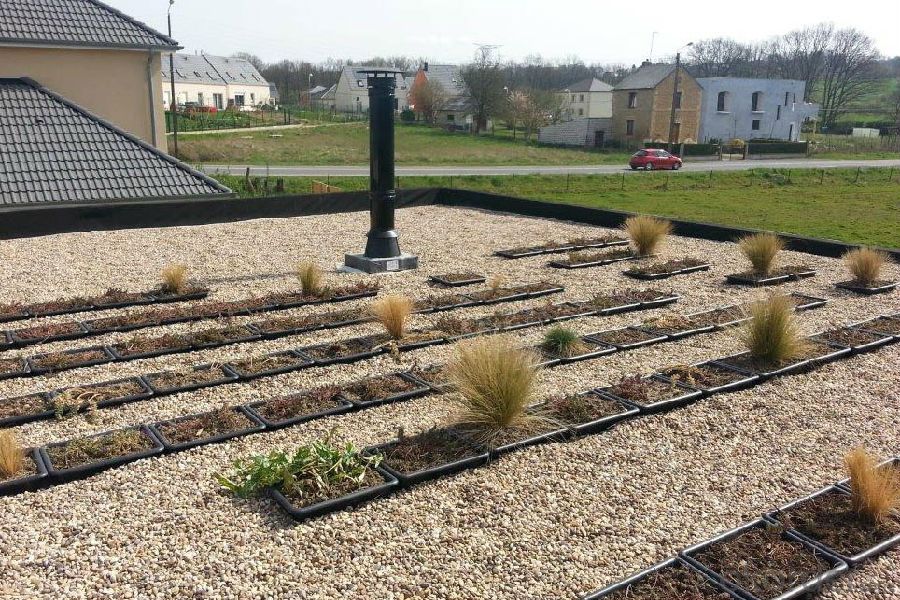

IMages of EPDM Coiled Waterproof Membrane with 1mm Thickness:
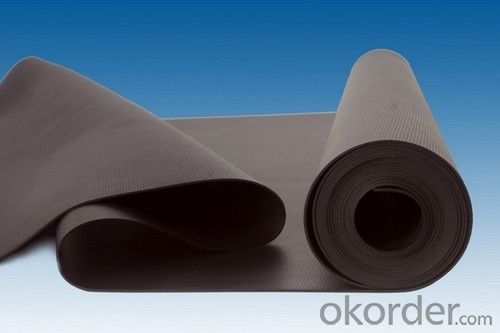
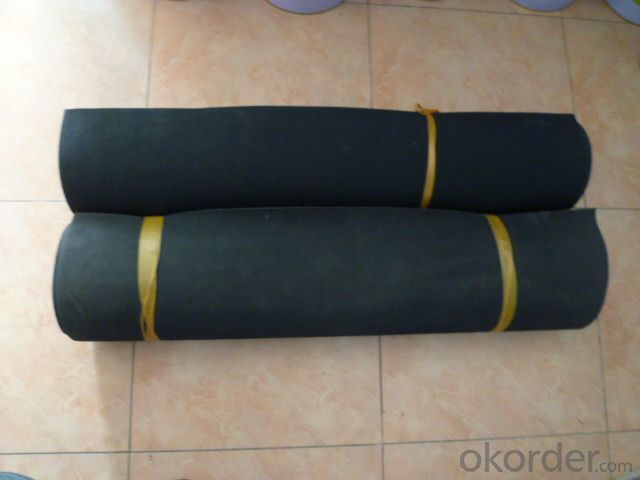


FAQ of EPDM Coiled Waterproof Membrane with 1mm Thickness:
1. What are we supplying?
We are specialized in producing Colorful Asphalt Roof Shingle, SBS/APP modified bitumen waterproof membrane, Self adhesive bitumen waterproof membrane, PVC waterproofing membrane, EPDM rubber roofing membrane, Single Component Polyurethane Waterproof Coating, and Spray Polyurea Waterproof Coating
.
2. How Many years experience do we have?
We have been exported to more than 20 countries in the past 15 years.
3. How long do we usually reply your request?
We always reply our customer within 24 hours.
- Q: Can waterproofing membranes be painted over?
- Painting over a waterproofing membrane is indeed possible. Nevertheless, it is crucial to verify the compatibility between the paint and the membrane material. It is advisable to refer to the manufacturer's guidelines or seek expert advice in order to guarantee the paint adheres well and lasts long. Furthermore, prior to applying the paint, the surface must be clean and dry to achieve optimal outcomes. All in all, painting over a waterproofing membrane can improve its aesthetic and offer extra safeguard against UV rays and other environmental elements.
- Q: Can a waterproofing membrane prevent water leakage in basements?
- Indeed, basements can be shielded from water leakage through the use of a waterproofing membrane. This membrane, whether applied externally or internally, serves as a protective shield against water infiltration by coating the walls of the basement. By doing so, it effectively halts water from seeping through the foundation walls, thus preventing any potential leaks or moisture-related problems within the basement. Acting as a watertight seal, the membrane ensures that water is unable to enter the basement, effectively safeguarding the structure from any harm that water damage may inflict. Nonetheless, it is crucial to acknowledge that the efficacy of a waterproofing membrane hinges on its correct installation and regular upkeep.
- Q: Does a waterproofing membrane require any special considerations for installation in earthquake-prone areas?
- Yes, a waterproofing membrane does require special considerations for installation in earthquake-prone areas. In these areas, the ground is more susceptible to movement and shaking, which can significantly impact the integrity of the waterproofing system. Therefore, it becomes crucial to take additional precautions to ensure that the membrane is properly installed and capable of withstanding seismic activity. One important consideration is the selection of the waterproofing membrane itself. It is recommended to choose a membrane that has been specifically designed and tested to withstand seismic activity. These membranes are usually more flexible and have higher tensile strength to accommodate ground movement during earthquakes. Additionally, the installation process should be executed with utmost care and attention to detail. The membrane should be properly anchored or secured to the substrate using appropriate fasteners and adhesives. Reinforcement techniques such as the use of reinforcing fabric or mesh can also be employed to enhance the membrane's resistance to movement. Furthermore, it is essential to ensure that all seams and joints in the membrane are properly sealed and reinforced. Special attention should be given to areas that are more prone to movement, such as corners, edges, and penetrations. Using compatible and high-quality sealants or adhesives will help maintain the integrity of these vulnerable points. Regular inspections and maintenance are also crucial in earthquake-prone areas. Inspecting the membrane periodically for any signs of damage, such as cracks or separations, allows for early detection and timely repairs. Additionally, it is vital to have a contingency plan in place to address any potential damage that may occur during an earthquake, including emergency repair procedures. In summary, installing a waterproofing membrane in earthquake-prone areas requires careful consideration and adherence to specific guidelines. By selecting an appropriate membrane, properly anchoring and reinforcing it, ensuring proper sealing of seams and joints, and conducting regular inspections, the waterproofing system can be better prepared to withstand earthquakes and provide long-lasting protection against water intrusion.
- Q: Can waterproofing membranes be used on precast concrete panels?
- Yes, waterproofing membranes can be used on precast concrete panels. Precast concrete panels can be susceptible to water penetration, which can lead to moisture damage and deterioration of the concrete. Waterproofing membranes are effective in preventing water infiltration by creating a barrier between the concrete surface and the external environment. These membranes are typically applied to the exterior surface of the precast panels, forming a protective layer that prevents water from seeping through the concrete. By using waterproofing membranes, precast concrete panels can be made more durable, longer-lasting, and resistant to moisture-related issues.
- Q: Is a waterproofing membrane resistant to solvents or chemical spills?
- Yes, a waterproofing membrane is typically resistant to solvents or chemical spills.
- Q: Are waterproofing membranes environmentally friendly?
- Depending on the type and installation, waterproofing membranes have the potential to be environmentally friendly. Some membranes are manufactured with recycled materials, which reduces the need for new resources and waste generation. Moreover, certain membranes are designed for durability and longevity, reducing the frequency of replacement and overall environmental impact. Nevertheless, it is crucial to consider the potential adverse environmental effects of waterproofing membranes. Some membranes are composed of synthetic materials that may release harmful chemicals into the environment during production or degradation. Furthermore, improper installation or disposal of these membranes can result in pollution and contamination of soil and water sources. To ensure the environmental friendliness of waterproofing membranes, it is essential to select products certified as sustainable or eco-friendly by reputable organizations. Additionally, hiring experienced professionals for correct installation minimizes the risk of leaks or damage that could lead to environmental issues. Lastly, proper disposal of old or damaged membranes is vital to prevent pollution and ensure responsible waste management. In conclusion, waterproofing membranes can be environmentally friendly if appropriate materials are chosen, installation is performed correctly, and disposal is handled responsibly. It is crucial to assess the environmental impact of these membranes and make informed choices to minimize any negative effects.
- Q: Sbs waterproofing membrane can make bathroom waterproof?
- And can be used in the basement, bridges, parking lots, swimming pools, tunnels and other buildings waterproof, moisture, steam, impermeable and various types of roof maintenance works, and the service life is very long, basically not bad,
- Q: Can a waterproofing membrane enhance the durability or lifespan of a structure?
- Yes, a waterproofing membrane can enhance the durability and lifespan of a structure by providing a protective barrier against water infiltration, preventing damage from moisture, leaks, and deterioration caused by water-related issues.
- Q: Can a waterproofing membrane be used for a parking garage?
- Indeed, a parking garage can benefit greatly from the utilization of a waterproofing membrane. Specifically designed to act as a barrier against water infiltration, this membrane effectively safeguards the underlying structure from potential moisture damage. Given the frequent exposure to water and moisture in parking garages due to rain, snow, and vehicle fluids, incorporating a waterproofing membrane is a vital aspect of the building envelope system. Its application on various concrete surfaces, such as the floor and walls, effectively prevents water seepage and subsequently hinders the occurrence of deterioration, corrosion, or any form of harm to the parking garage's structural integrity. Moreover, a waterproofing membrane also serves to mitigate the development of efflorescence, mold, and mildew, all of which are commonly found in damp environments. In conclusion, the implementation of a waterproofing membrane within a parking garage is an efficient approach to ensure the structure's long-term durability and functionality.
- Q: Can a waterproofing membrane be used for chemical storage facilities?
- Yes, a waterproofing membrane can be used for chemical storage facilities. It provides an effective barrier against moisture and can help prevent leaks or spills from contaminating the surrounding environment. However, it is important to ensure that the membrane is compatible with the specific chemicals being stored to avoid any potential chemical reactions or degradation of the membrane itself. Additionally, proper ventilation and safety measures should be in place to address any potential chemical hazards.
Send your message to us
EPDM Coiled Waterproof Membrane with 1mm Thickness
- Loading Port:
- Shanghai
- Payment Terms:
- TT OR LC
- Min Order Qty:
- 50000 m²
- Supply Capability:
- 5000000 m²/month
OKorder Service Pledge
OKorder Financial Service
Similar products
Hot products
Hot Searches
Related keywords
